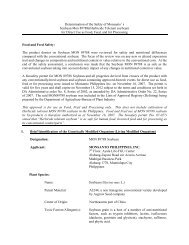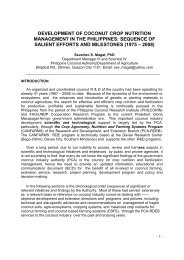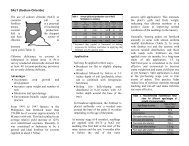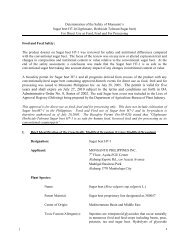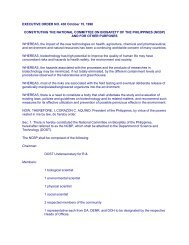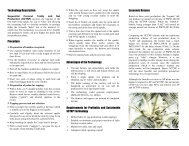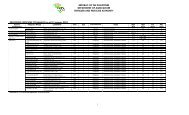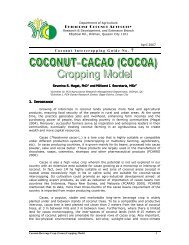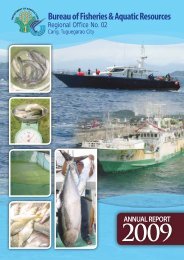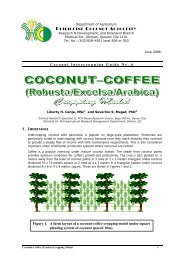Department of Agriculture - Philippine Coconut Authority ...
Department of Agriculture - Philippine Coconut Authority ...
Department of Agriculture - Philippine Coconut Authority ...
- No tags were found...
Create successful ePaper yourself
Turn your PDF publications into a flip-book with our unique Google optimized e-Paper software.
<strong>Department</strong> <strong>of</strong> <strong>Agriculture</strong>P HILIPPINE C OCONUT A UTHORITYResearch & Development, and Extension BranchElliptical Road, Diliman, Quezon City 1101February 2006<strong>Coconut</strong> Intercropping Guide No. 5Millicent I. Secretaria, MSc 1 and Severino S. Magat, PhD 21 Scientist I, PCA-Davao Research Center, Bago-Oshiro, Davao City,2 Scientist IV, PCA-Agricultural Research Management <strong>Department</strong>, Diliman, QC1. IMPORTANCEGrowing <strong>of</strong> intercrops in coconut lands produces more food andagricultural products, ensuring food security <strong>of</strong> the people in rural and urbanareas. At the same time, the practice generates jobs and livelihood, enhancingfarm incomes and the purchasing power <strong>of</strong> people, thus alleviating poverty infarming communities (Magat 2004). Moreover, successful farmers serve asinspiration and enterprise leaders in their communities, eventually treatingcoconut farming in an agribusiness way to create wealth and more capitalresources.Intercropping root crops under coconut palms is one <strong>of</strong> the popularintercropping practices in rural areas for many good reasons. Root crops serve asstaple food especially in regions or places where cereal grains (such as rice, corn)cannot be grown, people <strong>of</strong>ten rely upon starchy vegetables (roots, tubers orrhizomes) to supply most <strong>of</strong> their energy-calories. Such foods are called starchystaples. While such crops <strong>of</strong>ten have high yields, their primary disadvantage istheir low protein content [
Figure 1a. A farm layout guide <strong>of</strong> a coconut-root crop intercroppingmodel under square planting system <strong>of</strong> coconut with spacing<strong>of</strong> 8-10 meters and root crops (Cassava: 0.75-1.0 m x 0.50-0.75 m, between rows and hills, respectively).Figure 1b. A farm layout guide <strong>of</strong> a coconut-root crop intercroppingmodel under square planting system <strong>of</strong> coconut with spacing<strong>of</strong> 8-10 meters and root crops (Sweet Potato: 0.75-1.0 m x0.25-0.50 m, between rows and hills, respectively).<strong>Coconut</strong>-Root Crops Cropping Model 2
Figure 2a. A farm layout guide <strong>of</strong> a coconut-root crop intercroppingmodel under triangular planting system <strong>of</strong> coconut withspacing <strong>of</strong> 8-10 meters and root crops (Cassava: 0.75-1.0 m x0.50-0.75 m, between rows and hills, respectively).Figure 2b. A farm layout guide <strong>of</strong> a coconut-root crop intercroppingmodel under triangular planting system <strong>of</strong> coconut withspacing <strong>of</strong> 8-10 meters and root crops (Sweet Potato: 0.75-1.0 m x 0.25-0.50 m, between rows and hills, respectively).<strong>Coconut</strong>-Root Crops Cropping Model 3
2. ADVANTAGES AND BENEFITSDepending on the age or development stage <strong>of</strong> coconut, a variety <strong>of</strong> rootcrops are suitable and productive under coconut stands. Under the three growthstages (1,II, III) from field planting up to 26-60 years old, the proper root cropintercrops had been identified as shown in Table 1. Some <strong>of</strong> the commonlycultivated root crop intercrops under coconuts are: cassava (Manihot esculenta),sweet potato (Ipomea batatas), ubi or yam (Dioscorea species), gabi and ginger(Zingiber <strong>of</strong>ficinale, Rosc).Table 1. Growth duration and productivity periods, levels <strong>of</strong> sunlight transmissionand suitable intercrops (Magat, 2004).Phase(Stage)1IDurationFieldplanting6 yearstoLevel <strong>of</strong> available sunlight/ highly suitable intercropsHigh to Moderate/Highly Suitable Intercrops:Cereals - corn, upland riceLegumes - cowpea, peanut, mungbean, sitao, beansRoot crops - sweet potato, gabiFruit crops - pineapple, citrus, watermelon, papaya, bananaVegetables - tomato, cabbage, eggplant, sweet pepper, hotpepper, okraII 7-25 years 1 Moderate to Low/Highly Suitable Crops:Black pepper, cacao, c<strong>of</strong>fee, tomato, vanilla, ginger,lanzones, rambutan, durian, mangosteen, gmelina tree (forwood and lumber)III 26-60 years High/Highly Suitable Crops 2 :Cereals - corn, upland riceLegumes - peanut, mungbean, cowpea, beansVegetables - tomato, eggplant, cabbage, sweet pepper, hotpepper, okraRoot crops - sweet potato, gabi, cassava, ubi, gingerBeverage crops - c<strong>of</strong>fee, cacaoFruit crops - lanzones, rambutan, durian, mangosteen,citrus (pomelo, calamansi)Wood and Lumber tree - gmelinaFiber crops - ramie, abacaExcept tomato, usually the suitable crops indicated requires lower sunlight or moderate shadeduring the pre-bearing stage <strong>of</strong> the crops, thus field-establishment best done during this stage.2 Should more sunlight transmission to intercrops needed for normal growth and high yields,coconut leaf pruning (CLP) technique (removal <strong>of</strong> older lower leaves <strong>of</strong> the crown, maintainingthe upper 19-23 leaves); allowing 0.5 meter <strong>of</strong> cut frond attached to the trunk.Some <strong>of</strong> the key benefits <strong>of</strong> the coconut-root crop intercropping/ecosystem are asfollow:1) Root crops can be intercropped in coconut palms as young as 1-6 years oldand when these palms reached 25 years (and beyond). Generally, root cropsare heavy nutrient eaters, hence both crops should be supplied with therequired fertilizers needed by each crop.2) Root crops can be planted anytime <strong>of</strong> the year. They are alternative stablecrops being commonly planted in areas where our main staple crops (rice andcorn) are not really suitable for their cultivation.<strong>Coconut</strong>-Root Crops Cropping Model 4
While wholesale prices showed minimal fluctuations during the same period. The<strong>Philippine</strong>s has not imported any sweet potato during the last five years. Volume<strong>of</strong> exports had increased from a low <strong>of</strong> 116 kg in 1999 up to 950 kg in 2003.3.3 Ubi (Dioscorea alata) and Tugui (Dioscorea esculenta) are the two mostimportant yam varieties commonly cultivated in the <strong>Philippine</strong>s. They arecultivated in small patches <strong>of</strong> land, <strong>of</strong>tentimes less than a hectare, particularly insome regions <strong>of</strong> the <strong>Philippine</strong>s as Ilocos, Southern Tagalog, Bicol, CentralVisayas and Northern Mindanao. Recently, the commercial potential <strong>of</strong> ubi (D.alata Linn.) has been recognized in the country despite its being a minorcommodity (http://www.pcarrd.dost.ph/division/acd/ or PCARRD Ubi IndustrySituationer, 1998). Ubi is a promising and high value crop because <strong>of</strong> its growingdemand in the industry food sector in both local and export markets.3.4 Gabi (Taro) – is one <strong>of</strong> the most important root crops in the <strong>Philippine</strong>s(http://vicarp.lsu-visca.edu.p/technologies.htm). The <strong>Philippine</strong>s has the largestarea devoted to taro in Asia proper, apart from China(http:www.fao.org/docrep/005/ac450e/ac450e08.htm). In 1996, about 34,000hectares <strong>of</strong> land were devoted to taro, producing tuber root yields <strong>of</strong> about117,000 tons (FAO, 1997). Still taro is relatively a minor crop in the <strong>Philippine</strong>s.The food basket is dominated by rice and corn, with root crops as a group cominglower in the order. However, since about the mid-1990’s, a taro export trade hasgrown up in the <strong>Philippine</strong>s. The export goes mainly to New Zealand and themain operator for now is the DOLE International Company(http://www.fao.org//docrep/005/ac450e/ac450e08.htm). Many taro researcheshave been conducted at the Phil. Root Crop and Training Center (PRCTC) inBaybay, Leyte (Central <strong>Philippine</strong>s) based at the Leyte State University Campus(former Visayas State College <strong>of</strong> <strong>Agriculture</strong>).3.5 Ginger (Zingiber <strong>of</strong>ficinale, Rosc) is an important spice crop (mainlyharvested for the fresh mature roots) used in cooking, and preparing dishes andpreserves, candies and pickled food. It is a raw material in the production <strong>of</strong>beverage, perfumes and medicines although considered as a minor crop in the<strong>Philippine</strong>s. It is one <strong>of</strong> the country’s potential high – earning export crop.However, the national average yield is not highly impressive. So far, Farmers’limited knowledge about proper culture and management plus lack <strong>of</strong> knowledgefor ginger process have largely hindered the industry development((http://www.pcarrd.dost.ph/division/acd/ or PCARRD Ginger IndustrySituationer, 1981).4. GROWING CONDITIONS AND THE TECHNOLOGY4.1 Environmental RequirementsTo optimize the achievable yield <strong>of</strong> root crops under the coconut-root cropcropping system, it is essential to provide the suitable conditions (climate andsoils) for the two crops. Moreover, the competition for light, soil and waterresources usually results in marginal economic returns from one <strong>of</strong> thecomponent crops or in both.<strong>Coconut</strong>-Root Crops Cropping Model 6
eported to be the best. Gabi is best adapted to a warm and moistenvironment, a daily average temperature <strong>of</strong> 27- 29 o C is ideal for gabi.Below 27 o C, yield is reduced. Likewise, above 29 o C, the plants are stuntedand yield is greatly depressed. For best yield, an annual rainfall <strong>of</strong> 2000 mmis required throughout the growing period. It grows best at 1,800 metersabove sea level (http://www.da.gov.ph/farming tips).B.4 Ubi and Yam – are upland crops and they should be planted in well-drainedfield. Yam requires temperature ranging from 25-30 o C,sandy loam to siltloam soil with high organic matter, ample moisture throughout their growingperiod, particularly from 14-20 weeks after planting when tuber bulking(filling-up) occurs rapidly (http://vicarp.lsu-visca.edu.ph.ph/technologies.htm). Yams respond to length <strong>of</strong> daylight periods. Shortdaylights tend to favor tuber formation while long daylights favor vinegrowth.B.5 Ginger – grows best in sandy loam, clay loam and lateritic (reddish highlyweathered) deep soils <strong>of</strong> not less than 30 cm (PCA Intercropping Guide,undated).4.2 TechnologyIt is very important to apply the best package <strong>of</strong> technologies (POT) orbetter still, the site-specific technologies to achieve the maximum economic yield(MEY), highly desirable to obtain the least production cost per unit product or perha, and the maximum returns to investment under the coconut-root cropsproduction systems.4.2.1 Root crops4.2.1.1 Cassava1) Land preparation – prepare field by plowing 2-3 times, depending on thedegree <strong>of</strong> soil compactness and porosity, followed by harrowing when there isenough moisture. Make ridges with 15-20 cm high and 75-100 cm distancebetween furrows (Phil. Root Crops Information Service, VISCA, Leyte).2) Preparation <strong>of</strong> planting materials – select only fresh, mature or healthy stems- fresh if the latex or sap comes out within six (6) seconds after cutting,mature if the diameter <strong>of</strong> the pith or cork is not more than half the diameter<strong>of</strong> the cortex, healthy if it is pest-free and diameter <strong>of</strong> the stem is not lessthan 1.5 cm. Obtain stalks from a healthy stand which is at least 8 mos. old.Use a saw or bolo to separate cuttings 20-30 cm long. Keep the stalks for notmore than five days, undershade in upright position.3) Planting – plant cuttings in furrows one meter apart, each cutting set at 0.75to 1 m apart between ridges and 0.50 – 0.70 m between hills. Replant missinghills 2 weeks after planting. Weed the cassava plant within 2 months afterplanting. Plant in slanting position at angle <strong>of</strong> 45 o when the soil is fairly dryand in vertical position when planting is done during the wet season. At least15 cm <strong>of</strong> the cutting should be buried or covered with soil.4) Varieties – plant only high yielding varieties and according to needs. Forstarch, varieties VC-1, VC-2, VC-3, Datu. For food or feed purposes, it isstrongly recommended to use only Lakan or Golden Yellow varieties.<strong>Coconut</strong>-Root Crops Cropping Model 8
5) Fertilization – in the absence <strong>of</strong> laboratory soil analysis, the generalrecommendation is eight (8) bags (50 kg capacity) <strong>of</strong> complete (14-14-14)fertilizer per ha. Apply fertilizer 2-6 weeks after planting at 5-10 cm depth and15-20 cm away from the plant. The use <strong>of</strong> compost or organic fertilizer is alsohighly recommended as a soil conditioner and supplementary fertilizer(natural).6) Weeding and cultivation –At least 80% <strong>of</strong> the failed croppings <strong>of</strong> cassava isdue to inadequate weeding. Weed the plant within 2 months after planting. Ifpossible, do <strong>of</strong>f-barring and spot weeding 3-4 weeks after planting toeffectively control weeds, then weed the plant 4-5 weeks after planting. Hillupridges7-8 weeks after planting followed by spot weeding).7) Harvesting – Cassava is a highly perishable crop. It starts to deteriorate asearly as 1-3 days after harvest so harvest cassava at the right time and in theproper way. Harvest cassava at full maturity or 6-7 months after planting.Harvesting too early results in low yield and poor eating quality. On the otherhand, leaving the roots too long in the soil exposes them to pests. It also tiesthe land unnecessarily to one crop. Do not harvest cassava right after a heavyrain or when the soil is too wet. At this time, the roots have high watercontent which make them difficult to store. Also wet soil particles would stickeasily to the roots esp. if the soil is clayey, thus making the root hard toclean. Harvest during relatively dry weather so that you can easily remove thesoil particles from the roots).8) How to harvest8.1) If the soil is compact, loosen it first. Use a wooden tool because this cancause lesser root damage than metal tools.8.2) Pull the plant gently and don’t drag the roots, dragging can causebruises and cuts to roots which may lead to early deterioration).8.3) In separating root from the plant, do not just break it <strong>of</strong>f because thismethod can also cause root damage. Cut each root as close to the stemas possible).8.4) After harvesting, don’t leave the roots under the sun. Too much heatcauses weight loss and early root deterioration).9) How to store cassava9.1) Soil storage method – select a suitable site which is well-drained,preferably shaded and slightly sloping. Do not keep cassava inwaterlogged area because roots will decay easily. In selected area, digtrenches measuring one meter in width and 30-40 cm in depth. Thelength <strong>of</strong> the trench varies according to the volume <strong>of</strong> roots to store. Ameter long trench can contain 70-80kg roots).9.2) Storage <strong>of</strong> roots in wooden crates10) Pest control – There is no serious pest that attacks the cassava plant and use<strong>of</strong> the chemical is not practical or economical. To avoid the attack <strong>of</strong> pest,apply crop rotation or burn all infested or infected plants).11) Processing <strong>of</strong> cassava – can produce several food products like flour, starch,tapioca and alcohol etc. Cassava root part has a disadvantage, its fleshy rootscontain poisonous compounds (cyanogenic glycosides – compounds thatliberate cyanide) that must be removed (http://www.bio.ilstu.edu/armstrong/syllabi/cassava/cassava.htm). Shredding the roots and squeezing<strong>Coconut</strong>-Root Crops Cropping Model 9
out the juice removes much <strong>of</strong> the toxic compounds. Heat used to dry theresulting flour removes the remaining compounds. The resulting flour, calledfar<strong>of</strong>a is very bland, rather like corn meal and flour. The flour can be mixedwith water and the dough cooked on a large griddle to make a large cassavaflat-breads).4.2.1.2 Sweet potato1) Land preparation – To have good root yield <strong>of</strong> the crop, plow and harrow thesoil twice until soil is loose and friable. Form ridges or furrows <strong>of</strong> about 30-40cm high by using carabao-drawn mold-board plow or tractor-drawn moldboard plow or tractor-drawn disc plow with a distance <strong>of</strong> about 75-100 cmsbetween ridges (http://www.da.gov.ph.farming tips [from BPI Sweet PotatoCommodity Pr<strong>of</strong>ile –DA-Eastern Visayas Integrated Agric .Research Center]) ).2) Planting materials and variety – Use sprouts from roots <strong>of</strong> previous crop orvine tip cuttings from healthy plants 25 cm long. However, for economicreasons, tip or terminal vine cuttings immediately or you can store them inshaded place but they should be planted within 2 days from the time the theyare cut).The selection <strong>of</strong> the proper variety to grow is dependent on the purpose forwhich it is grown. The following 14 varieties are recommended by the Phil.Seed Board: UPL SP1, UPL SP 3, UPL SP5, BPI SP 1, BPI SP 2, PSB SB -13,14,15,16,17, UPL SP, VSP -5,6,7 (http://www.da.gov.ph.farming tips[from BPI Sweet Potato Commodity Pr<strong>of</strong>ile –DA-Eastern Visayas IntegratedAgric .Research Center]) ).3) Planting – plant vine cuttings diagonally on top <strong>of</strong> ridges during the rainyseason to prevent the crop from being soaked under water, or in the furrowsduring dry season so that moisture reserve in the soil can be utilized by thecrop. Expose 2-3 leaves at the tip at a distance <strong>of</strong> 25 cms between hills. Onecutting per hill is equivalent to 33,000 hills per ha).4) Fertilization –In the absence <strong>of</strong> soil analysis <strong>of</strong> the area, follow the generalfertilizer recommendation for: poor soil, use 4-6 bags complete (14-14-14)fertilizer /ha, moderate fertile soil – use 4 bags complete fertilizer/ha, forfertile soil, fertilization is not advisable. Apply fertilizer at planting time at 8-10 cms from the base <strong>of</strong> the plant or broadcast in the furrows and coversubsequently with soil. The use <strong>of</strong> compost or organic fertilizer at 3 tons/ha ishighly recommended).5) Cultivation and weeding – If weeds are abundant, shallow cultivation is done10-12 days after planting. Hilling-up cultivation is done at 25-30 days afterplanting. This is to provide enough soil to cover the developing roots andthus, minimize the entry <strong>of</strong> weevils that may attack the growing roots).6) Pest and disease management – Foliar spraying <strong>of</strong> fevinthrothion at 0.5% one(1) month after planting and twice at 50 days and 70 days after planting(DAP).7) Harvesting – Most <strong>of</strong> the recommended varieties are ready for harvest 110-130 DAP. Harvesting can be determined by root sampling and if desired sizehas been attained, harvesting can be done anytime. Before harvesting, cutand roll the vines like a mat, fork, hoe or pass a plow below the ridges, then<strong>Coconut</strong>-Root Crops Cropping Model 10
hand pick the roots. Handle the roots carefully to minimize injury. Sort outdamage or bruise roots from undamaged ones).8) Post harvesting operation – If possible, use wooden crates for containersinstead <strong>of</strong> gunny sacks to avoid skin damage during handling and transport.Harvest roots, if properly cured can be stored even for 3 months by keepingthem under room temperature <strong>of</strong> 115 o F or 32 o C with a relative humidity <strong>of</strong> 92-95).9) Post harvesting diseases – S<strong>of</strong>t rot or ring rot and storage rot are two commondiseases after harvesting. Control measures include storage <strong>of</strong> roots in clean,dry and well-ventilated storage area; care must be taken not to bruise orinjure roots during harvest and transport).4.2.1.3 Gabi1) Planting Materials – are called setts. A sett is prepared from a plant ordaughter plant, i.e, either sucker or rhizome. The setts are prepared byhaving 1-2 cm tip section <strong>of</strong> the parent corm and first 15-25 cm <strong>of</strong> the petiole.The suckers are prepared from pre-sprouted cormels or cut from main corm.Best results are obtained with a sett size <strong>of</strong> 100-120 g. Smaller-sized settscan be used but maturity is delayed. Planting materials should be uniform insize but if different sizes <strong>of</strong> setts are used plant together those that are moreor less <strong>of</strong> the same size (http://vicarp.lsu-visca.edu.ph/technologies.htm).2) Land Preparation - Alternate plowings and harrowing until the soil is thoroughlyprepared for planting and weed-free. Irrigation For Lowland culture –irrigation is maintained at least 3-5 cm water depth during the first threemonths <strong>of</strong> the crop to produce good quality corms. Drain the field once in awhile.3) Varieties <strong>of</strong> Gabi (with average yield per cropping):oooooPSB-VG#1 – (7.2 tons/ha)PSB-VG#2 – (6.7 tons/ha)SB-VG#3 – (7.2 tons/ha)PSB-VG#4 – (6.5 tons/ha)NSIC-G-8 – (7.0 tons/ha)o NSIC-G-6 - (7.0 tons/ha4) Planting Methods4.1 Lowland or flooded culture. The area is flooded first for three days. Plowingand harrowing is done after flooding. Submerge the field in water for 2 daysbefore planting. The gabi setts are planted in the mud with a spacing <strong>of</strong> 75 cmbetween rows and 50 cm between hills. http://www.nomiarc.netfirms.com/pot/gabi.htm).4.2 Upland or dry cultivativation (culture). More suitable in coconut-based areas.Furrows are prepared at a distance <strong>of</strong> 75 cm apart and 30 cm deep. The settsare planted at a distance <strong>of</strong> 50 cm between hills).<strong>Coconut</strong>-Root Crops Cropping Model 11
5) Fertilization - Compost or manure is recommended during planting at the rate<strong>of</strong> 2 tons/ha. Split application <strong>of</strong> inorganic fertilizers will be at the rate <strong>of</strong> 30-30-30 kg NPK per hectare. This corresponds to: 5 bags 21-0-0 or 1.5 bagsurea + 3.5 bags 0-18-0 (solophos) + 1 bag 0-0-60). One half <strong>of</strong> this amountis usually applied 2 weeks after planting and the remaining 1/2 is 2 monthsafter planting.6) Weeding and hillling up - In lowland culture, practically no weeding is needed.Flooding itself provides some degree <strong>of</strong> weed control. For upland culture,weeding is done during the first two months after planting or before thecanopy is sufficient to cover up to the ground. Hilling up should be done 2months and 4 months after planting).7) Storage - Best temperature to prolong storage is 7°C and gabi can last up to3.5 months. Gabi stored in pits can last for 6-10 months provided it isminimally exposed to rains).8) Pest/Disease Management - Insect pests like aphids, army worms,hornworms and grasshoppers attacking gabi plants can be controlled byspraying appropriate insecticides. For gabi disease like leaf blight, theapplication <strong>of</strong> fungicides is an effective control practice. For plants that showsymptoms <strong>of</strong> virus infection, removing and burning the plants are goodcontrol measures).9) Harvesting - Gabi is ready for harvest when matured leaves turn yellow ormanifesting signs <strong>of</strong> senescence. Lowland cultivars mature 7-12 months whilethe upland cultivars can be harvested 8 months after planting).4.2.1.4 Ubi1) Land Preparation – For a field that has been cultivated previously, twoplowings and two harrowings are usually enough for yams. However, plowingshould be made deep as yam requires at least a moderately deep loose soil).The flat bed and the ridged bed types appear to be preferable to the othertypes <strong>of</strong> seedbed. When the latter is used, the ridges should be constructedone meter or 60 cm apart. In the case <strong>of</strong> sloping or rolling fields, construction<strong>of</strong> ridges should follow the contour to minimize soil erosion).2) Preparation <strong>of</strong> Setts - In yams, setts are whole tubers or tuber pieces used forplanting. For ubi, whole tubers and tuber pieces are used while only wholetubers are used for tugui. Setts weigh from 60 g to 250 g in the case <strong>of</strong> ubiand 100 g to 150 g in the case <strong>of</strong> tugui. As a rule, the bigger the sett used,the higher is the expected yield although the increase in yield for every unitincrease in sett weight decreases).Setts should be taken from healthy tubers <strong>of</strong> healthy plants. In ubi, tubers <strong>of</strong>appropriate sett size are not sliced while larger tubers are sliced into thedesired sett size so that each sett has sufficient skin surface area. Thus in ubi,four types <strong>of</strong> setts are obtained and are named according to their positions onthe tuber viz: head setts, middle setts and tail setts for the tuber pieces andwhole setts for the whole tubers).Cut sides <strong>of</strong> the setts are treated with ash or with fungicide and air dried.After air drying, setts are either pre-sprouted or planted directly).<strong>Coconut</strong>-Root Crops Cropping Model 12
3) Pre-sprouting <strong>of</strong> Setts - Because the emergence period <strong>of</strong> most freshlyprepared setts in the field lasts from three to twelve weeks, it is desirable topre-sprout the setts before they are planted. This procedure assures theemergence <strong>of</strong> setts in the field and minimizes expenses on weeding beforesett emergence).A shallow ditch is dug in a clear shaded area under trees, under bananas, orunder a shed constructed for the purpose. Setts are placed side by side in theditch. In cases where no ditch is dug, the setts are placed side by side on theground instead).Setts are grouped according to type. For setts cut from large tubers, theorientation is either skin up or crown sideways. Setts are covered with a thinlayer <strong>of</strong> soil and are watered at least once a week until all have producedsprouts).With sett pre-sprouting, it may be desired to stagger planting and landpreparation since setts do not sprout at the same time. In general, wholesetts and head setts sprout ahead <strong>of</strong> other sett types. Planting pre-sproutedsetts can also be done at one time).4) Preparation <strong>of</strong> pre-sprouted setts for:4.1 Staggered planting - To prevent sprouts from becoming too long, settsthat have already sprouted are removed from the pre-sprouting seedbed andplaced on a platform in a shady place. The process is repeated every weekuntil the desired number <strong>of</strong> sprouted setts is obtained. The sprouted setts onthe platform are not watered. Setts are planted before sprouts become verylong. The same procedure is performed for setts intended for the second andsucceeding plantings).4.2. Single planting - The procedure followed in single planting is essentiallythe same as that used in preparing setts for staggered planting. The former isdone only after most, if not all, setts have produced sprouts. By this timesome sprouts which shall have grown quite long should be trimmed before thesetts are planted).5) Planting - The usual planting time for ubi is March to May and occasionallyuntil June, depending upon the time the tuber dormancy is broken, asindicated by the sprouting <strong>of</strong> tubers under storage and upon start <strong>of</strong> rain in aparticular area).5.1 Non-pre-sprouted setts. Setts are planted on the seedbed (ridged or flat)at a distance <strong>of</strong> 1 m x 50 cm or 60 cm x 60 cm and at a depth <strong>of</strong> about10 cm. When planting coincides with a dry spell, setts are planted in anyorientation about 15 cm deep if the field will not be mulched. About20,000 to 27,778 setts are needed for one hectare.5.2 Pre-sprouted setts. Setts are usually planted at the start <strong>of</strong> rain if thefield cannot be irrigated or will not be mulched. The same plantingdistance and depth for non-pre-sprouted setts are used. When planting,setts should be oriented so that sprouts are up.In staggered planting, the field is divided into four up to six sections - asection for a batch <strong>of</strong> setts ready for planting. The size <strong>of</strong> each section<strong>Coconut</strong>-Root Crops Cropping Model 13
and the time each section is prepared is guided by the rate <strong>of</strong> sprouting<strong>of</strong> setts.6) Mulching - In order to reduce soil temperature, conserve soil moisture andsuppress weed growth, it is preferable to mulch the field planted to yams. Drycoconut fronds, corn stalks, rice straw and other similar materials may beused as mulch. If rice straw or similar material that rot readily is used, themulch is made thick (about 10 cm) so that it will not rot completely withinfour or five months).7) Weeding - The number <strong>of</strong> times an ubi field needs to be weeded dependsupon the use <strong>of</strong> pre-sprouted setts, the application <strong>of</strong> mulch and the rate <strong>of</strong>weed growth. If non-pre-sprouted setts are used and the field is not mulched,three to five weeding operations are needed before the yam canopy coversthe space between rows to partially suppress weed growth. If pre-sproutedsetts are used and the field is mulched, at most only two weedings performedabout two months apart are needed).Handtools and animal-drawn implements are used to weed the field. Whileplants are still short and unstaked or if the stake structure allows their use,animal-drawn implements are used in an unmulched field. This requires thatvines that cross the path <strong>of</strong> the animal be first removed and placed along therows. However, if the plants have been staked and the stake setup does notallow use <strong>of</strong> animal-drawn implements or if the field is mulched, onlyhandtools are used.8) Replanting - Some amount <strong>of</strong> sett mortality can be expected, particularly inubi when non-presprouted setts are used for planting. Thus replanting isdone, usually about two months after planting).Hills with no sprouts are checked to see if there are rotten setts which shouldbe removed and replaced with new ones. Unsprouted setts that did not rotshould not be replaced because they still can produce sprouts ).9) Hilling Up - In the case <strong>of</strong> unmulched ridge seedbed, rain and handweedingoperations <strong>of</strong>ten level down ridges. Thus, it is necessary to hill up at leastonce about two or three months after planting).When the plants are still short and unstaked, animal-drawn implements maybe used in hilling up. In this case, the vines that cross the path <strong>of</strong> the animalare first lifted and placed along the rows. When stakes are already set up andtheir presence do not allow the use <strong>of</strong> animal-drawn implements, handtools,usually shovels, are used).10) Staking - Plants are staked before vines start crawling on the ground. Therecommended stake length is one to two meters and a stake to every plant.Bamboo poles, wood, cassava stalks, talahib stalks or any similar materialthat can support the yam vines for at least seven months can be used asstakes. If cassava stalk is used, it is set up in an inverted position (top portionburied) so that it will not produce new shoots. There are various methods <strong>of</strong>staking, three <strong>of</strong> the more popular ones are as follows).10.1 Trellis method - This stake setup is not very stable and requires morematerials to support the stakes (posts and tie wire). However, weedingand hilling up operations using animal-drawn implements can be doneeasily under this setup).<strong>Coconut</strong>-Root Crops Cropping Model 14
10.2 Modified trellis method - With this method, ground spaces under thestake arch need not be weeded as the foliage becomes dense. Also,stakes formed in this manner provide stable support. However, weedingand hilling up operations that utilize animal-drawn implements cannot bedone under the arches).10.3 Pyramid method - This staking method has the advantages anddisadvantages <strong>of</strong> the modified trellis method. In addition, it requiresfewer, though sturdier, materials for stake construction and requireslesser amount <strong>of</strong> labor to construct. On the other hand, it has anadditional disadvantage because yams grown under this method usuallyyield lower than those grown under the modified trellis method).11. Training the Vines - The ubi vine twines to the right while that <strong>of</strong> tugui twinesto the left. When vines start crawling on the ground, they are trained to climbtheir respective stakes. They are trained again when long branches startcrossing the rows or when weeding and hilling-up operations using animaldrawnimplements are about to be done).12. Fertilizer Application - A hectare <strong>of</strong> ubi removes about 128 kg nitrogen, 17 kgphosphorous and 162 kg potassium from the soil. These nutrients areequivalent: 6 bags 21-0-0; 2 bags solophos and 5.5 bags potassium chloride(0-0-60). This represents the crop’s average fertilizer requirements(http://vicarp.lsu-visca.edu.ph.ph/technologies.htm). In the case <strong>of</strong> tugui, noinformation is available regarding the amount <strong>of</strong> nutrients it can remove fromthe soil. However, like other yams, its fertilizer requirements is very likelysimilar to that <strong>of</strong> ubi crop).The level <strong>of</strong> soil fertility in the field and the amount <strong>of</strong> fertilizer that need tobe applied are determined by the soil analysis (mainly chemical properties)submitted to a proper soils laboratory. The site-specific fertilizationmanagement could be determined with the extension assistance <strong>of</strong> the localAgriculturist or Farm Management Technician.12.1 Application <strong>of</strong> inorganic fertilizer - The recommended amount <strong>of</strong> fertilizeris split into two, one-half applied about one month after emergence andthe other half applied about two months after the first application. Theband method <strong>of</strong> fertilizer application is used, with the fertilizer beingplaced about 10 cm away from the plants).12.2 Application <strong>of</strong> compost -Yams respond well to organic fertilizers likecompost - a mixture <strong>of</strong> decayed organic matter composed <strong>of</strong> plant partsand animal manures. The compost is mixed with the soil while the field isbeing prepared or it is placed just below the spot where setts are to beplanted).12.3 Covering Exposed Tubers - As tubers elongate rapidly towards the end<strong>of</strong> the growing period <strong>of</strong> the plants, some tubers tend to heave, therebycausing them to be exposed to the sun. Heavy rains also expose thetubers. Exposed tubers should be covered with soil to prevent them fromgreening).13. Harvesting - Ubi is ready for harvest when its foliage is already yellowing ordrying up. In tugui, only the basal leaves turn yellow; the rest remaininggreen, even when new sprouts have already emerged from the base <strong>of</strong> theplant. The yellowing or drying up period <strong>of</strong> the foliage usually starts in lateNovember and lasts until February the following year. In general, ubi matures<strong>Coconut</strong>-Root Crops Cropping Model 15
ahead <strong>of</strong> tugui by about one month. Tubers, especially those intended forsetts, are harvested at the later part <strong>of</strong> the period. Tubers intended forconsumption or for the market are sometimes harvested earlier, even beforefoliage yellowing sets in).A bolo or a similar handtool is used to dig around the tuber to loosen it fromthe soil. Then the tuber is lifted and clinging soil particles are removed. Thevine is cut at the base).For sandy soil, sturdy stick sharpened at one end is sometimes used to dig outthe tuber. For clay soil and for varieties with deeply buried tubers, an ubiharvester devised at PRCRTC may be used. The harvester is used like ashovel. Whatever tool is used to harvest the tubers, it is important that careshould be exercised so as not to injure them while digging).After tubers are cleaned, they are collected and placed in rattan baskets orbamboo or wooden crates lined with s<strong>of</strong>t materials such as banana leaves,paper or grass straw. Healthy and diseased tubers are placed in separatecontainers. The tubers are arranged in the container in two to four layers,depending upon tuber size, and a s<strong>of</strong>t material that can serve as cushion isplaced between layers and in the spaces between tubers in a layer. Thecontainer is then covered with paper or banana leaves and a string net iswoven over the mouth <strong>of</strong> the container if the tubers are to be transportedimmediately to the market. No cover is provided for the container if the tubersare to be transported to a nearby storage place. The tubers should betransported with minimum <strong>of</strong> jolting using a cart or a sled. (Root Crop Digest,PRIS Vol. 2 No. 4, 1987 ISSN 0116-4325 [http://vicarp.lsuvisca.edu.ph/technologies.htm).4.2.1.5 Ginger1) Land preparation – Plow and harrow twice or thrice to remove weeds, makefurrows 50 cm apart, 2.0 m away from the base <strong>of</strong> the coconuts).2) Varieties – Some <strong>of</strong> the varieties <strong>of</strong> ginger are: a)Native –small, fibrous andpungent rhizome; b) Imugan – improved native strain, medium –sizedrhizomes with prominent leaf scars, resistant to soil-borne diseases and yield30-70% more than native strain; c) Jamaica ‘oya” –pleasant aroma, pale,medium-sized rhizomes which turn brownish-yellow when dried; d) Hawaiian– extra large, yellowish brown with pinkish traces (PCA Intercropping Guide).3) Preparation <strong>of</strong> planting materials – Procure planting materials from reliablesources, use only fresh and healthy rhizomes. Cut rhizomes into seed pieces<strong>of</strong> about 20 grams each containing 2-3 bud-eyes. Wash seed pcs in tap waterand then soak in solution containing 45 grams Captan per 20 li <strong>of</strong> water for10-15 minutes. Plant seed pcs immediately).4) Maintenance –Fertilize with one (1) tbsp <strong>of</strong> complete fertilizer (1414-14) eightcm away from hills as side dressing. Gather coconut leaves, rice straws, driedbanana leaves, cogon straws and mulch the planted area. Apply 400 kg/ha <strong>of</strong>complete fertilizer on the 2 nd and 4 th months).5) Harvesting – can be done when stalks exhibit yellowing and withering, aboutnine (9) months after planting. Two methods <strong>of</strong> harvesting for:<strong>Coconut</strong>-Root Crops Cropping Model 16
5.1 Small plantation – three (3) laborers may harvest the crop: one digs thehills with spading fork, second pulls out the plants, shakes <strong>of</strong>f the soiland lays them on the ground, third trims <strong>of</strong>f the stems (taking care therhizomes do not break) and spreads the rhizomes to dry).5.2 Large scale plantation –plow the ground to loosen soil and rhizomes6) Curing/storing – Haul harvested ginger to an open shed, spread evenly to airdry.7) Pest and disease management – Some <strong>of</strong> the pests <strong>of</strong> ginger are mealy bug,black armyworm, aphid, shoot borer and can be controlled by insecticidespraying or by practicing crop rotation. Disease s like leaf spot, s<strong>of</strong>t rot,baterial, fusarium wilt and root knot attack ginger plant. Control measures areindicated in PCA Intercropping Guide, undated).4.2.2 COCONUTWith the coconut trees are already established and already at bearingstage, the main farming practices are fertilization, underbrushing-weeding,mulching <strong>of</strong> the main rootzone <strong>of</strong> coconut (also considered the fertilizing zone attrunk base <strong>of</strong> trees), and harvesting. Post-harvest and primary processingpractices (seasoning <strong>of</strong> partially immature nuts for 7–10 days, dehusking andcopra processing) are common in small to medium scale farms. If sold to coconutdesiccating plants, dehusked nuts are immediately marketed. <strong>Coconut</strong> husksawait decortication/defibering, while coconut shells are converted to charcoal andsold to the shell charcoal sellers and the activated carbon processors.There are two average inorganic/mineral fertilizer recommendations forcoconut: 1) using the combination <strong>of</strong> single fertilizers (ammonium sulfate pluscommon salt (for potassium-rich soils) or potassium chloride (0-0-60) for soilsdeficient in K; and 2) using ready-to-apply multinutrient fertilizers as the 14-5-20-0.02 (B), now commercially available like COCOGRO (ATLAS Brand) or OsakaPlanters Fertilizers in 25-kg and 50-kg bags.These two fertilizer recommendations are compatible with the application<strong>of</strong> appropriate organic fertilizers (compost, cocopeat, commercial organicfertilizers). If capital resources to purchase organic fertilizers is available, any<strong>of</strong> these organic fertilizers ( total N, P and K <strong>of</strong> at least 5%) may be appliedtogether with the mineral fertilizers (options 1 and 2) indicated below at the rate<strong>of</strong> 3-4 times <strong>of</strong> the periodic rates indicated. Organic fertilizers should be appliedabout a month ahead <strong>of</strong> the application <strong>of</strong> the inorganic/mineral fertilizers.Organic fertilizers serve best as soil conditioners and fertilizer supplements to thecoconut-vegetable cropping system.Option 1Application <strong>of</strong> Single-Fertilizers (per tree):Age/StageRate <strong>of</strong> Fertilizer Combination aField-planting (FP)150 g AS + 160 g SC or 200g KCl6 months from FP 200 g AS + 200 g SC or 200 g KCl1 year 500 g AS + 450 g SC or 600 g KCl<strong>Coconut</strong>-Root Crops Cropping Model 17
2 years 750 g AS + 750 g SC or 900 g KCl3 years 1.0 kg AS + 1.25 kg SC or 1.5 kg KCl4 years 1.25 kg AS + 1.35 kg SC or 1.70 kg KCl5 years and onwards 1.50 kg AS + 1.70 kg SC or 2.00 kg KCla AS – Ammonium sulfate (21-0-0);SC – Sodium chloride (common salt);KCl – Potassium chloride (0-0-60)Field-planting (FP)Option 2Application <strong>of</strong> ready-to-apply multinutrientfertilizer (per tree):Rate <strong>of</strong> 14-5-20Age/Stagemulti-nutrient Fertilizer a400 g6 months from FP 600 g1 year 1.25 kg2 years 1.50 kg3 years 2.00 kg4 years 2.50 kg5 years and onwards 3.00 kga contains 14% N, 5% P2O5, 20% K2O plus 15% Cl , 4.5%S, 0.02% Boron, Ca.5. INVESTMENT NEEDS: COSTS AND RETURNSFor one hectare <strong>of</strong> coconut land or in a pure stand <strong>of</strong> coconut, only about25% <strong>of</strong> the soil mass is actually utilized by the coconut (Magat, 1999). Theremaining 75% <strong>of</strong> coconut land can be productively utilized by planting suitableintercrops e.g. root crops. Thus, if the effective land use index (ELUI) is assumedat: 0.40 ha for cassava, 0.35 ha for sweet potato, the total land use index addsto 1.75 ha or 75% increase in land use intensity (LUI) over 1 ha coconutmonocropped. Hence, in the annual cropping cost and return analysis <strong>of</strong> coconut+ root crops cropping model, the ELUI for each intercrop planted with thestanding coconuts is used.Table 5.1 and 5.2 shows the an average cost and return analysis <strong>of</strong>coconut + cassava + sweet potato cropping model, covering a 3-year productionperiod. For each component intercrop, details <strong>of</strong> costs involved in the productionare indicated. Please take note that the cost and return analysis varies dependingon local farm inputs and prices <strong>of</strong> farm produce, particularly at farm gate price <strong>of</strong>each component root crop. The same is true with main crop, coconut, theeconomic conditions and local prices <strong>of</strong> copra as well as coconut products, usuallydictated by global price trends, serves as important basis <strong>of</strong> pr<strong>of</strong>itability incoconut farming.<strong>Coconut</strong>-Root Crops Cropping Model 18
Table 5.1 An estimated costs and returns analysis <strong>of</strong> coconut + cassava +sweet potato intercropping system (3-yr cropping period), datafor cassava and sweet potato mainly from DA-BAS (2001-03).Crop/Cost item Year 1 Year 2 Year 3Cassava ( 0.40 ha)Cash Cost: ( seeds, fertilizers, pesticides, 1,594 1,629 1,781hired labor, other material inputs andexpenses)Non-cash Cost: (hire-labor paid in kind, 301 301 382harvester’s share, lease rental)Imputed Cost: (operator/family labor, 2,566 2,648 2,835depreciation, interest on operatingcapital, rental value <strong>of</strong> owned land)Total Costs 4,461 4,578 4,997Returns:Gross Returns 10,062 9,897 12,562Returns over cash costs 8,467 8,268 10,781Net Returns 5,600 5,319 7,564Yield per 0.40 ha (kg) 3,174 3,132 3,102Price per kg (farmgate) 3.17 3.16 4.05Production cost/kg 1.41 1.46 1.61Crop/Cost item Year 1 Year 2 Year 3Sweet potato ( 0.35 ha)Cash Cost (seeds/fertilizer/pesticides 2,228 2,354 2,519Hired labor, land tax, fuel. Oil)Non-cash Cost (hired labor-paid in kind 442 529 536Harvester’s share)Imputed cost (operator & family labor, 2,265 2,385 2,532exchange labor, depreciation)Total Costs 4,935 5,268 5,587Returns:Gross Returns 7,995 9,827 9,930Net Returns over cash costs 5,767 7,472 7,411Net Returns 3,060 4,559 4,343Yield per 0.35 ha (kg) 1,532 1,570 1,566Price per kg (farmgate) 5.22 6.26 6.34Production cost/kg 3.22 3.36 3.57Crop/Cost item Year 1 Year 2 Year 3<strong>Coconut</strong> (1 ha):@ 2 t copra/ha, @P15/kg or Nuts=8000/haFertilizer application P360 360 360Circle-weeding, 4.5 md a , 6x/yr P2,430 2,430 2.430Fertilizer cost b P2,000 P2,000 P2,000Cost <strong>of</strong> harvesting, piling,hauling,P2,800 P2,800 P2,800dehusking @ P0.35/nutCopra making @ P0.12/kg P960 P 960 P960Transport/Handlings, @P0.20/kg P400 P 400 P400Total Cost P8,950 P8,950 P8,950Yield (kg copra/ha) 2,000 2,000 2,000Gross Income P30,000 P30,000 P30,000Net Income P21,050 P21,050 P21,050aman-daysbaverage fertilization: 1.5 kg AS + 1.7 Kg NaCl (common salt) @ P 5/kg and P 4/kg,respectively, @ 135 trees/ha.<strong>Coconut</strong>-Root Crops Cropping Model 19
Table 5.2 Summary <strong>of</strong> 3-year average <strong>of</strong> Costs and Returns <strong>of</strong> a <strong>Coconut</strong>+ Cassava + Sweet potato in a 3-year period cropping model(Land Use Intensity = 1.75 ha: 1 ha coconut, 0.40 ha cassavaand 0.35 ha sweet potato)EconomicIndex<strong>Coconut</strong>(1.0 ha)Cassava(0.40 ha)Sweet Potato(0.35 ha)Total• Total Cost P8,950 P4,679 P5,263 P18,892• Yield (kg) 2,000 3,136 1,556 6,692• Gross Income P30,000 10,840 9,251 50,091• Net Income P21,050 6,161 3,987 31,198• Prodn. costP4.47 1.49 3.38 9.34(per kg)6. POTENTIAL FINANCING SOURCES/CREDIT FACILITIES• Self or In-House Finance (Private)• Local Government Units (Municipal, Provincial, Congressional)• Government Banks & Lending Institutions• Private Banks and Lending Agencies• Cooperatives• Foundations<strong>Coconut</strong>-Root Crops Cropping Model 20
REFERENCES:Magat, S.S. 2004. Growing <strong>of</strong> intercrops in coconut lands to generate more foodand agricultural products, jobs, and enhancing farm incomes. <strong>Coconut</strong>Intercropping Primer. PCA-RDEB, Diliman, Quezon City.Magat, S.S. 1999. Production management <strong>of</strong> coconut (Cocos nucifera L.)Published by PCA, Diliman, Quezon City. 67 p.PHILIPPINE COCONUT AUTHORITY (undated). Intercropping coconut with gabi.PCA Brochure.PHILIPPINE COCONUT AUTHORITY (undated). Intercropping coconut with ginger.PCA Brochure.PCARRD-DOST. 1983. The Phil. Recommends for Cassava. Los Banos, Laguna.Phil. Council for <strong>Agriculture</strong>, Forestry and Natural Resources Researchand Development (PCARRD).PCARRD-DOST. 1997. The Cassava Industry Situationer. Los Banos, Laguna. Phil.Council for <strong>Agriculture</strong>, Forestry and Natural Resources research andDevelopment.PCARRD-DOST. 1998. The Ubi Industry Situationer. Los Banos, Laguna. Phil.Council for <strong>Agriculture</strong>, Forestry and Natural Resources research andDevelopment.Plant Industry Production Guide on Sweet Potato. BPI Sweet Potato CommodityPr<strong>of</strong>ile. DA-Eastern Visayas Integratedc Agricultural Research Center.Storing and Processing <strong>of</strong> Cassava DA-RFU 9. Phil. Root Crops InformationService VISCA, Baybay, Leyte.From the internet:http://bas.gov.ph/downloads_view.phphttp://www.da.gov.ph/updates/farming tips (cassava, sweet potato, ginger)http://www.bio.ilstu.edu/armstrong/syllabi/cassava/cassava.htmhttp://education.yahoo.com/reference/encyclopedia/entry/cassavahttp://health.yahoo.com/drughttp:/www.nomiarc.netfirms.com/pot/gabi.htmhttp://vicarp.lsu-visca.edu.ph/technologies.htmhttp://www.fao.or//docrep/005/450e/ac450e08.htm<strong>Coconut</strong>-Root Crops Cropping Model 21
FOR MORE INFORMATION AND ASSISTANCE,YOU MAY CONTACT THE FOLLOWING OFFICES SITUATED NEAR YOU:• Research & Development, and Extension Branch, PCA, Diliman,Quezon City 1101Telefax: 920-0415 Tel: 426-1398 Email: cbcarpio@mozcom.com orssmagat@pacific.net.ph or sev_magat@yahoo.com• Field Services Branch, PCA, Diliman, Quezon City 1101Telefax: 928-9488 Tel: 929-1590• Albay Research Center (ARC), PCA, Banao, Guinobatan AlbayTel: (052) 484-6686 or 484-6685 Email: pcaarcvb@globalink.net.ph• Davao Research Center (DRC), PCA, Bago-Oshiro, Davao City, PO Box80437Tel: (082) 293-0115/0116/0119 Fax No. (082) 293-0571 Email:pcadrc@pldtdsl.net or pcaasd@pldtdsl.net• Zamboanga Research Center (ZRC), PCA, San Ramon, ZamboangaCity, PO Box 356 Tel: (0917) 710-1820 Email: pca_zrc@pldtdsl,net• PCA Region IV-B (MIMAROPA and rest <strong>of</strong> Luzon) Diliman, Quezon CityTelefax: 924-4761 Tel: 927-5227 E-mail: pcaiv@mozcom.com• PCA Region V (Bicol) , Sagpon, Legaspi CityTel: (052) 245-5263 Fax: (052) 245-5263 E-mail: pca-r5@globalink.net.ph• PCA Region VI (Western Visayas), 12 Mabini St., Iloilo CityTel: (033) 337-7514 Fax: (033) 335-0977 E-mail:pca_r6@skynet.net• PCA Region VII (Central Visayas), DA7, Mandaue City (CEBU)Tel: (032) 345-0009 Fax: (032) 345-8435 E-mail:alambino@yahoo.com• PCA Region VIII (Eastern Visayas), Gov’t Center, Candahug, Palo,Leyte Tel: (053) 323-2698 Fax: (053) 323-2995E-mail:pca8jop@mozcom.com• PCA Region IX (Western Mindanao), J.P. Rizal St., Zamboanga CityTel: (062) 991-6369 Fax: (062) 992-1031 E-mail:pcar9@jetlink.com.ph• PCA Region X (Northern Mindanao), #30 Daumar St., Cagayan De OroCity Tel: (088) 857-3707 Fax: (088) 272-2814 Email: pca10@philcom.com• PCA Region XI (Southern Mindanao), PCA Complex, Bago-Ohiro,Tugbok District, Davao City Tel: (082) 293-0384 Telefax: (082) 293-0049E-mail:pca11@pldtdsl.net• PCA Region XII (Central Mindanao), 2 nd Flr, AS Bldg. , Cor. JP Laureland CM Recto Sts, General Santos CityTel: (083) 544-6263 Telefax: (083) 553-9424Email: pca12@mozcom.com• PCA Region XIII (CARAGA), JC Aquino Ave., Pajera Subd., ButuanCity Tel: (085) 815-3232 Fax: (085) 226-4621E-mail:pca13@skynet.net• PCA-ARMM, Emilio Ong Bldg., Quezon Ave., Cotabato CityTelefax: (064) 421-2412.Drafted by:MI Secretaria/SS MagatPCA/DRC-ASD/RDEB-ARMD20 & 27 February 2006<strong>Coconut</strong>-Root Crops Cropping Model 22



